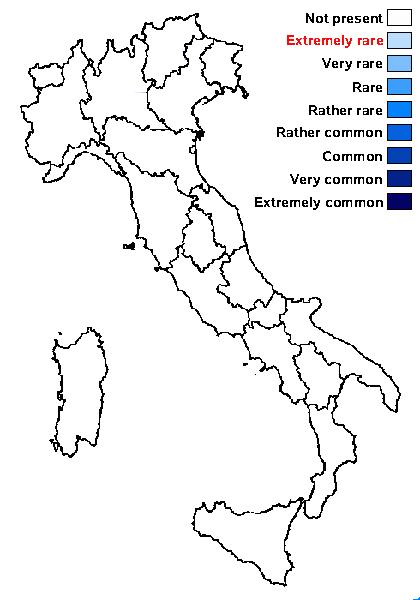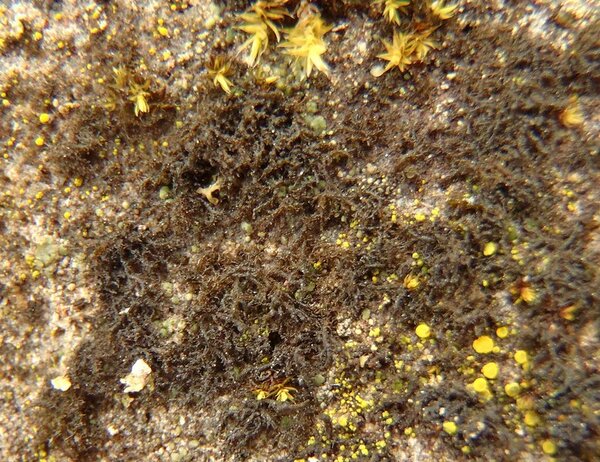Ephebe perspinulosa Nyl.
in Norrl., Meddeland. Soc. Fauna Fl. Fenn., 1: 7, 1876.
Synonyms: Ephebe papillata H. Magn.; Ephebe trachytera (Nyl. ex Vain.) Henssen; Ephebeia perspinulosa (Nyl.) Räsänen
Distribution:
Description: Thallus microfruticose-filamentous, brown-black to black, dark-green to brown when wet, attached by a narrow gelatinous holdfast, of terete, pointed filaments with numerous short, spinule-like side branches, (25-)50 µm thick in upper parts, 75-100(-110) µm thick in basal parts, forming 2-10 mm wide tufts. Thallus (in section) ecorticate, the mycobiont cells loosely paraplectenchymatous, short-celled. Apothecia sessile, c. 0.2 mm across, lateral or terminal, developing from pycnidia on swellings on the branches, with a punctiform, dark brown disc, and a thin, persistent thalline margin. Proper exciple thin or absent; epithecium brownish; hymenium gelatinous, colourless, I+ blue-green, K/I+ blue; paraphyses sparingly branched, the apices thickened; hypothecium colourless. Asci 8-spored, cylindrical-obclavate, with a very thin wall disintegrating or opening by apical ruptures, Lichina-type. Ascospores 1-celled, hyaline, globose, 4-6 µm wide. Pycnidia black, developing laterally from the filaments. Conidia bacilliform, 2.5-4 x c. 1 µm. Photobiont cyanobacterial (Stigonema), the photobiont trichomes with true branching, i.e. side branchlets formed by periclinal cell divisions in the trichome, reacting I-. Spot tests: all negative. Chemistry: without lichen substances. Note: on periodically wetted siliceous rocks above and near treeline. To be looked for in the Italian Alps.
Growth form: Fruticose filamentous
Substrata: rocks
Photobiont: cyanobacteria, filamentous (e.g. Nostoc, Scytonema)
Reproductive strategy: mainly sexual
Periodically submerged (e.g. in creeks)
Commonnes-rarity: (info)
Alpine belt: absent
Subalpine belt: absent
Oromediterranean belt: absent
Montane belt: absent
Submediterranean belt: absent
Padanian area: absent
Humid submediterranean belt: absent
Humid mediterranean belt: absent
Dry mediterranean belt: absent

Predictive model
Growth form: Fruticose filamentous
Substrata: rocks
Photobiont: cyanobacteria, filamentous (e.g. Nostoc, Scytonema)
Reproductive strategy: mainly sexual
Periodically submerged (e.g. in creeks)
Commonnes-rarity: (info)
Alpine belt: absent
Subalpine belt: absent
Oromediterranean belt: absent
Montane belt: absent
Submediterranean belt: absent
Padanian area: absent
Humid submediterranean belt: absent
Humid mediterranean belt: absent
Dry mediterranean belt: absent

Predictive model
 INDEX FUNGORUM
INDEX FUNGORUM
 GBIF
GBIF



